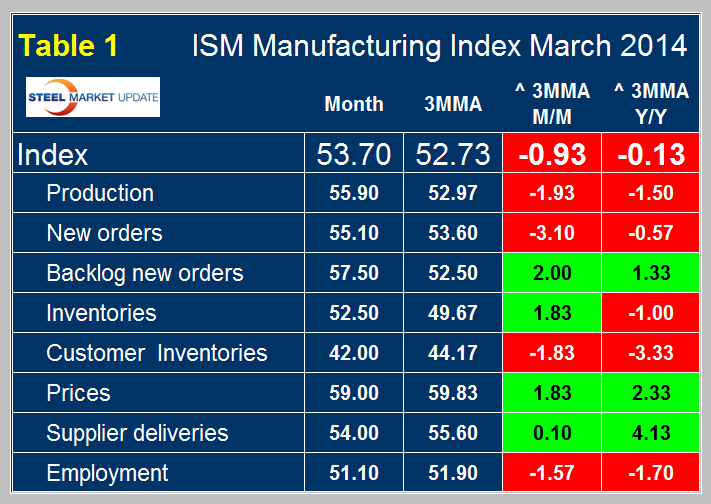Economy

Manufacturing Advanced Again in March
Written by Peter Wright
April 1, 2014
The Institute of Supply Management report was issued today by Bradley J. Holcomb, CPSM, CPSD, chair of the Institute for Supply Management (ISM) Manufacturing Business Survey Committee. “The March PMI registered 53.7 percent, an increase of 0.5 percentage point from February’s reading of 53.2 percent, indicating expansion in manufacturing for the 10th consecutive month. The New Orders Index registered 55.1 percent, an increase of 0.6 percentage point from February’s reading of 54.5 percent. The Production Index registered 55.9 percent, a substantial increase of 7.7 percentage points compared to February’s reading of 48.2 percent. Employment grew for the ninth consecutive month, but at a lower rate by 1.2 percentage points, registering 51.1 percent compared to February’s reading of 52.3 percent. Several comments from the panel reflect favorable demand and good business conditions, with some lingering concerns about the particularly adverse weather conditions across the country.”
Of the 18 manufacturing industries, 14 are reporting growth in March in the following order: Petroleum & Coal Products; Transportation Equipment; Furniture & Related Products; Paper Products; Printing & Related Support Activities; Plastics & Rubber Products; Fabricated Metal Products; Machinery; Textile Mills; Computer & Electronic Products; Nonmetallic Mineral Products; Food, Beverage & Tobacco Products; Chemical Products; and Primary Metals. The four industries reporting contraction in March are: Apparel, Leather & Allied Products; Wood Products; Electrical Equipment, Appliances & Components; and Miscellaneous Manufacturing.
Moody’s summarized as follows in Economy.com: “Factory conditions improved slightly in March as the ISM manufacturing index rose from 53.2 to 53.7. The increase bucked our expectation for a small decline, and the details were mixed. Production bounced back after abnormal winter weather depressed activity in the prior two months. With weather normalizing, supplier deliveries fell 4.5 points to 54. New orders rose in March but remain well below the level in the second half of last year when manufacturing was doing well. Inventories were unchanged and the employment index fell from 52.3 to 51.1 for March. The ISM manufacturing index was better than we expected, providing further evidence that weather’s drag on the economy is fading.”
SMU Comment: The March report is more good news for manufacturing which accounts for over half of total steel consumption in the US. The details of our analysis are shown in Table 1 and included a historical review of prices and customer inventories. The individual sector values are shown for March with the three month moving average. The direction of the index is shown by a comparison of Q1 2014 with Q4 2013 and by a year / year comparison, Q1 2014 with Q1 2013. Both comparisons show that production and new orders continue to grow though more slowly. Backlogs and prices are strengthening and accelerating, customer inventories are low and contracting. Employment is growing but more slowly.

Figure 1 shows the progression of the index on a 3MMA basis since January 1997. Growth has been positive since August 2009.

Explanation: The Manufacturing ISM Report on Business is published monthly by the Institute for Supply Management, the first supply institute in the world. Founded in 1915, ISM exists to lead and serve the supply management profession and is a highly influential and respected association in the global marketplace. ISM’s mission is to enhance the value and performance of procurement and supply chain management practitioners and their organizations worldwide. This report has been issued by the association since 1931, except for a four-year interruption during World War II. The report is based on data compiled from purchasing and supply executives nationwide. Membership of the Manufacturing Business Survey Committee is diversified by NAICS, based on each industry’s contribution to gross domestic product (GDP). The PMI is a diffusion index. Diffusion indexes have the properties of leading indicators and are convenient summary measures showing the prevailing direction of change and the scope of change. A PMI reading above 50 percent indicates that the manufacturing economy is generally expanding; below 50 percent indicates that it is generally declining. A PMI in excess of 42.2 percent, over a period of time, indicates that the overall economy, or GDP, is generally expanding; below 42.2 percent, it is generally declining. The distance from 50 percent or 42.2 percent is indicative of the strength of the expansion or decline. With some of the indicators within this report, ISM has indicated the departure point between expansion and decline of comparable government series, as determined by regression analysis.

Peter Wright
Read more from Peter WrightLatest in Economy

Industry groups praise Senate for passing tax and budget bill
The Steel Manufacturers Association and the American Iron and Steel Institute applauded the tax provisions included in the Senate's tax and budget reconciliation bill.

Chicago PMI dips 0.1 points in June
The Chicago Purchasing Managers Index (PMI) slipped 0.1 points to 40.4 points, in June.

Multi-family pullback drives housing starts to 5-year low in May
US housing starts tumbled in May to a five-year low, according to figures recently released by the US Census Bureau.

Architecture firms still struggling, ABI data shows
Architecture firms reported a modest improvement in billings through May, yet business conditions remained soft, according to the latest Architecture Billings Index (ABI) release from the American Institute of Architects (AIA) and Deltek.

Manufacturing in New York state contracts again
However, companies are growing more optimistic about the future.
